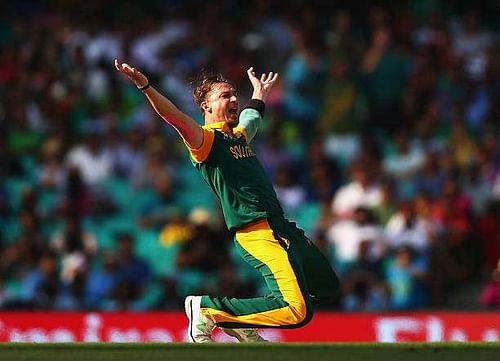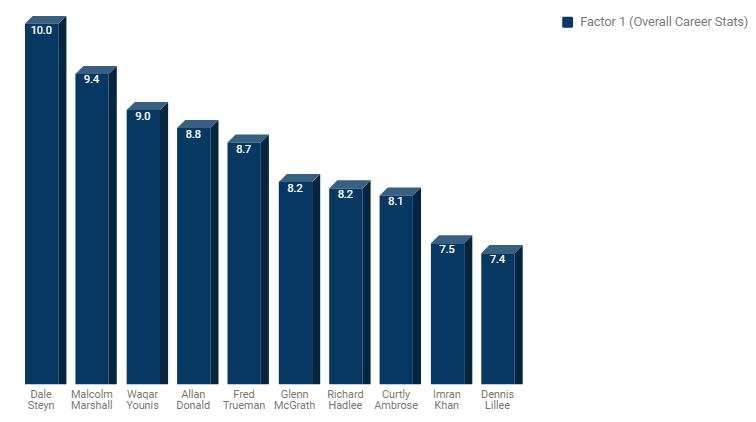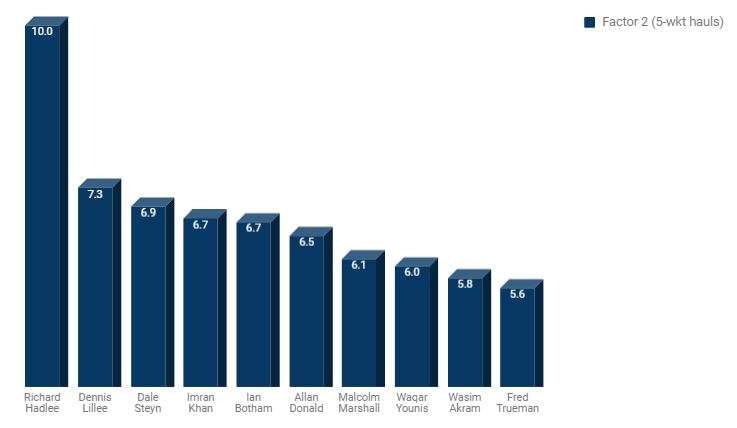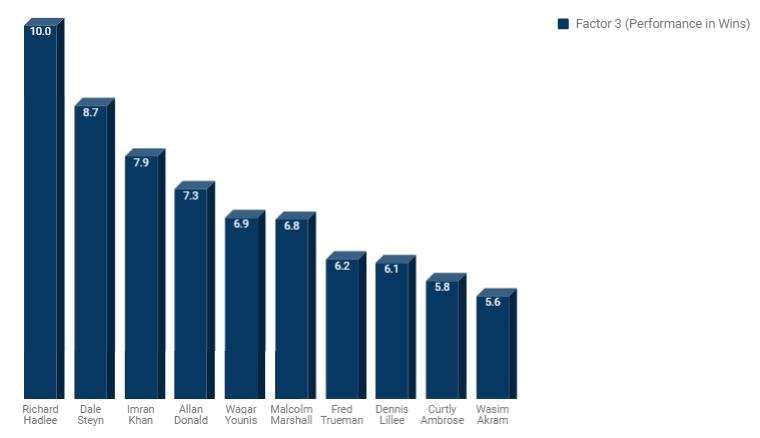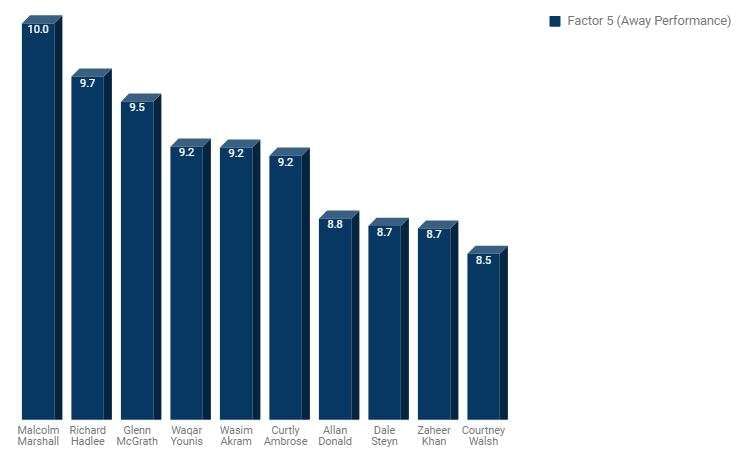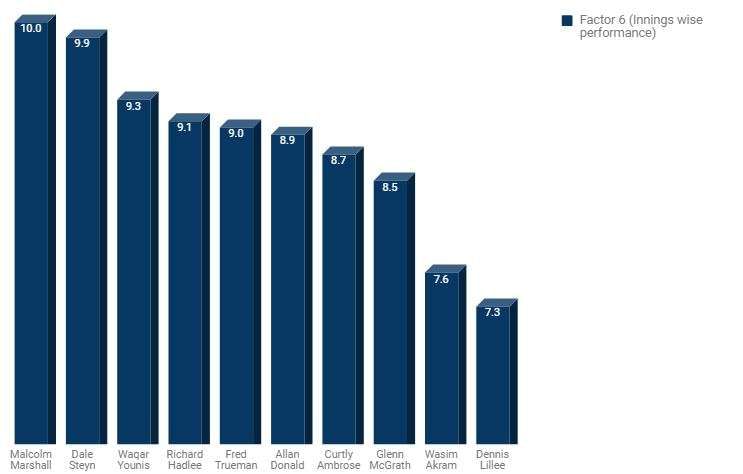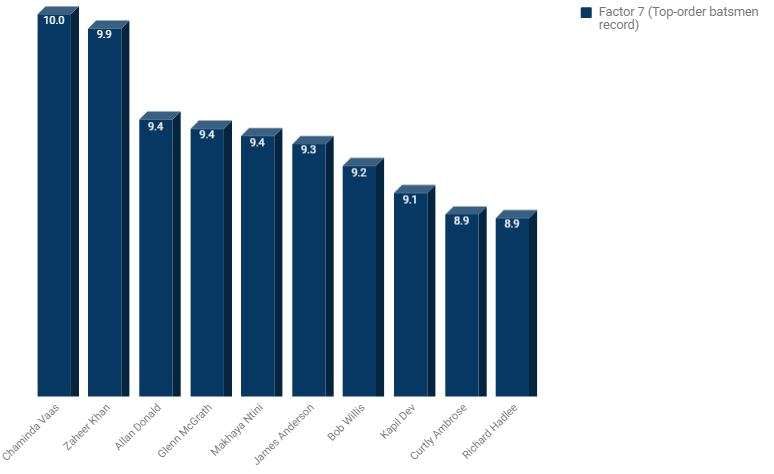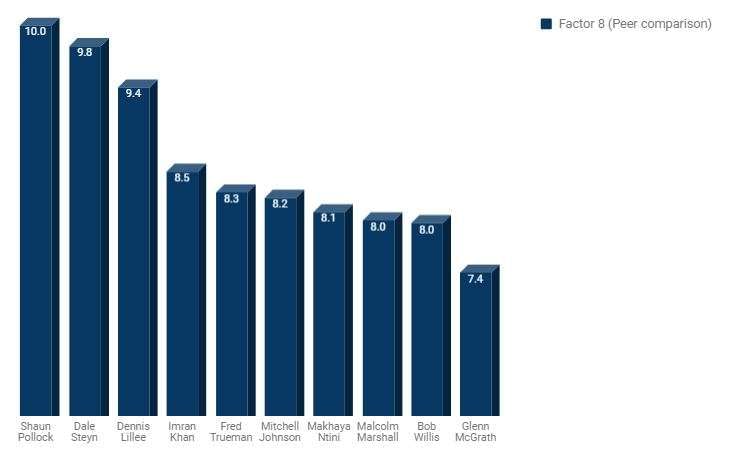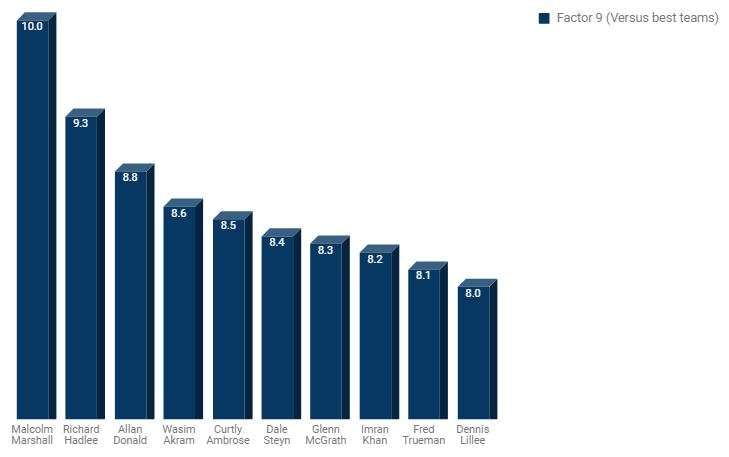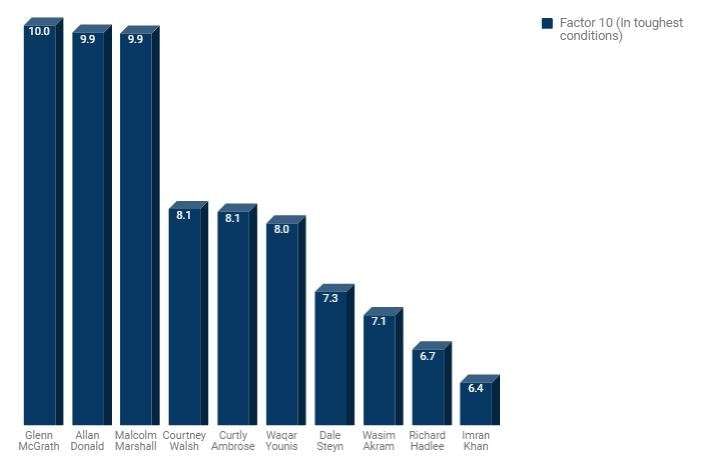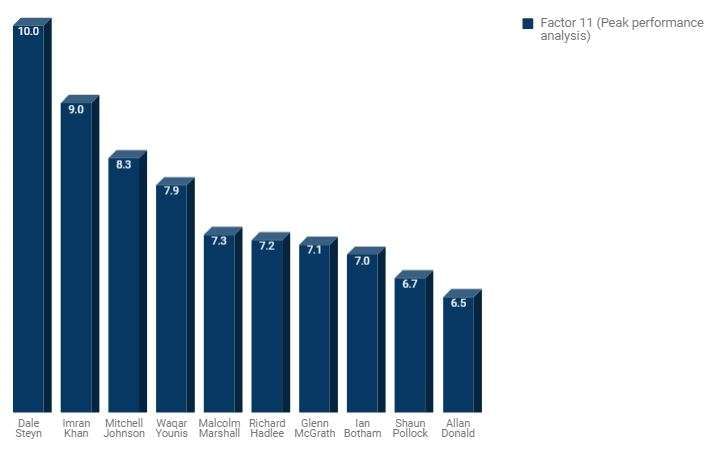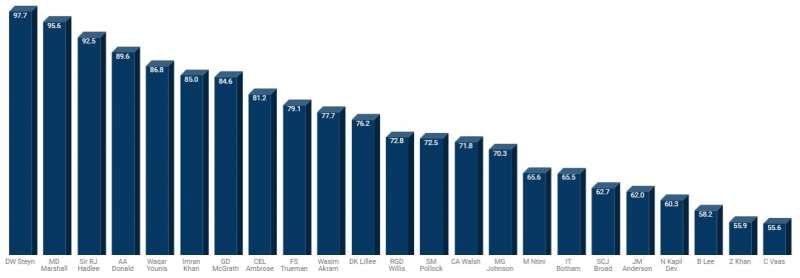
Dale Steyn - the best in the business of 'pace'
I don’t know about some of you but I am very sure that a huge proportion of cricket fans spend a massive amount of their YouTube time looking for videos related to pace bowlers and their exploits. The sight of shattered stumps, beautiful outswingers taking the edge and carrying chest high to the slip cordon, the snaking delivery that moves back in and traps a set batsman plumb in front – aren’t these the most amazing moments the sport offers?
Throughout my cricket watching years (about 25 years now on TV and a whole lot of YouTube), I seem to recall a long list of terrific contests involving top fast bowlers and the finest batsmen. The Wasim Akram special to Rahul Dravid in Chennai, the Shoaib Akhtar deliveries to Dravid and Sachin Tendulkar at Eden Gardens, the Curtly Ambrose-Steve Waugh face off, Malcolm Marshall nipping Andy Lloyd’s career in the bud, and Jeff Thomson & Dennis Lillee terrorizing England in the Ashes through the 1970s – the very mention of these is enough to bring back heady replays. What better way to display my love for fast bowling than working on a detailed analysis that aims to find out who the best paceman has been?
In this extraordinarily enjoyable and complex exercise, I take into account 11 different factors that will help determine (statistically) who has been the ‘ace of pace’. At the outset I would want to state that there is absolutely no room for subjective opinion in this analysis and each factor has been allotted equal weight.
So, what then are the 11 factors being considered here?
The idea was to analyse every major aspect that determines how good a fast bowler is. I have gone on to consider Overall performance, 5-Wicket hauls, Performance in wins, Home performance, Away performance, Innings-wise performance, Stats versus top-order batsmen, Peer performance, Performance against best teams, Performance in tough conditions and Peak performance analysis.
In all factors, I calculate the Quality Factor (QF) = (strike rate * bowling average)/100.
The rationale is that lower the QF, the better the performance. The scores in the particular category are normalised by setting the best performance to 10.
Note that the analysis is restricted to fast bowlers who have picked up 300 or more wickets.
Factor 1 – Overall Performance
When we consider the overall career performance, Dale Steyn comes up on top followed by Malcolm Marshall and Waqar Younis. Steyn, who has suffered a dip in form after a few injuries, is still the man to emulate because of his exceptional strike rate of 41.4 (the best among all bowlers), Marshall, who is perhaps the best fast bowler to emerge from the West Indies, has the best average (20.94) and a brilliant strike rate (46.7). The trio of Allan Donald, Fred Trueman Glenn McGrath and Richard Hadlee are in the middle while Ambrose, Imran Khan and Dennis Lillee round off the top 10.
Factor 2 – 5 wicket hauls
Fast bowlers tend to wrest control of matches by picking up the wickets of the best batsmen. More often, when fast bowlers pick up 5 or more wickets in an innings, their team is almost inevitably in the better position as the match progresses. Factor 2 considers the number of innings taken per five-wicket haul. In this analysis, the peerless Richard Hadlee comes up on top (4.1 innings per 5-wicket haul) followed by Dennis Lillee (5.73 innings per 5-wicket haul) and Dale Steyn. Imran Khan, Ian Botham and Allan Donald are next with Wasim Akram and Fred Trueman completing the top 10.
Factor 3 – Performance in wins
The best fast bowlers step up when it matters. Think back to Steyn’s magnificent spell at Nagpur in 2010 when he ran through the powerful Indian batting line-up. Or picture Ambrose ripping Australia apart in Perth with THAT spell of 7/1. Almost every good fast bowler has a much better QF in wins relative to the overall career QF. In some cases, the performance in wins is scarcely believable. Richard Hadlee is more than twice as good in wins while Steyn is not too far behind. The incomparable Pakistan legend Imran Khan is third followed by Donald and Waqar Younis. For years, Kapil Dev carried the burden for India and this is reflected in his amazing display in wins – his QF is more than twice as good as his corresponding overall career number.
Factor 4 – Performance in home Tests
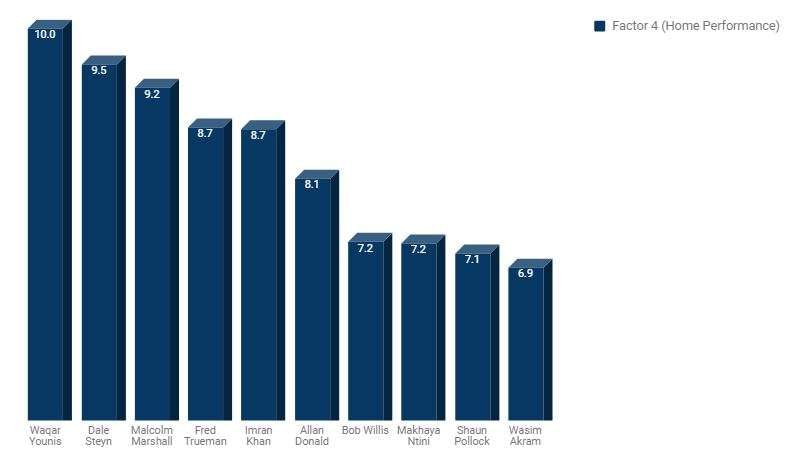
Home dominance is the foundation that most teams look to lay before they embark on attempts to conquer opposition in challenging away conditions. While fast bowlers from outside the subcontinent have had more pace-friendly conditions, the subcontinent bowlers often toil in conditions that are hardly helpful. In this context, Waqar Younis’ display is fantastic; he has a home Tests QF nearly 25% better than his career QF. Steyn and Marshall follow in second and third position. The top ten also features two new entries – Bob Willis, who is famous for his stunning 8/43 in the legendary Leeds Test of 1981, and Makhaya Ntini, a highly under-rated match winner for South Africa especially in home conditions.subcontinent bowlers often toil in conditions that are hardly helpful. In this context, Waqar Younis’ display is fantastic; he has a home Tests QF nearly 25% better than his career QF. Steyn and Marshall follow in second and third position.
The top ten also features two new entries – Bob Willis, who is famous for his stunning 8/43 in the legendary Leeds Test of 1981, and Makhaya Ntini, a highly under-rated match winner for South Africa especially in home conditions.subcontinent bowlers often toil in conditions that are hardly helpful. In this context, Waqar Younis’ display is fantastic; he has a home Tests QF nearly 25% better than his career QF. Steyn and Marshall follow in second and third position. The top ten also features two new entries – Bob Willis, who is famous for his stunning 8/43 in the legendary Leeds Test of 1981, and Makhaya Ntini, a highly under-rated match winner for South Africa especially in home conditions.subcontinent bowlers often toil in conditions that are hardly helpful. In this context, Waqar Younis’ display is fantastic; he has a home Tests QF nearly 25% better than his career QF.
Steyn and Marshall follow in second and third position. The top ten also features two new entries – Bob Willis, who is famous for his stunning 8/43 in the legendary Leeds Test of 1981, and Makhaya Ntini, a highly under-rated match winner for South Africa especially in home conditions.
Factor 5 – Away Test performance
Cricket fans tend to argue about almost every topic – big or small. However, there is one topic where opinion is hardly divided. The best players are the ones who perform in tricky away conditions and set up the platform for their team to succeed when the odds are stacked against them. Cricket history is filled with top-class fast-bowling displays in away conditions. Marshall in the mid-1980s was a cut above everyone else on the tours of Australia and England and played a massive role in the 3-0 thrashing of India in the series after the 1983 World Cup. Ambrose seemed to reserve his best for England and Australia while McGrath seemed to succeed wherever he bowled. This complex factor is calculated as a sum of two sub-factors – the QF in away matches and the % of wickets in away games (as a % of total career wickets). Marshall comes out on top followed by Hadlee and McGrath. The two Ws, Wasim and Waqar, round off the top five while Zaheer Khan, who was India’s talisman in away Tests for most of the 2000s, makes his way into the top 10.
Factor 6 – Innings Wise Performance
While the first and second innings of matches mostly offer a lot more for fast bowlers, there are quite a few occasions when reverse swing comes into play especially in the third and fourth innings as the pitch dries up. An overcast morning combined with some bad luck at the toss can be a hammer blow. Consider the fourth Ashes Test at Trent Bridge in 2015 where Australia were shot out for just 60 with Stuart Broad picking up 8/15. Few can forget Curtly Ambrose ripping through England (46 all out) in Trinidad in 1994 as he bowled West Indies to a remarkable win. This complex factor analyses a bowler’s performance in each innings while also considering the overall QF for bowlers in each innings. For example, if the QF for a bowler in innings 1 is 40 and innings 2 is 50, the two scores are adjusted to reflect the true challenge of bowling in those innings by considering the overall pace bowler performance in that particular innings. So, if pace bowlers have a QF of 40, 45, 50 and 55 in the four innings, the weight allocated to an individual QF score is (40/55 = 0.72), (45/55 = 0.81), (50/55 = 0.91), (55/55 = 1).
After this adjustment, Marshall comes out on top followed by Steyn and Waqar Younis. There is hardly anything to choose among the next three – Hadlee, Trueman and Donald. Hadlee, in particular, has an exceptional QF in the 4 th innings (the best among all bowlers). An interesting observation is that Imran Khan has a very poor QF (38.42) – the worst among all bowlers.
Factor 7 – Record against top-order batsmen
An important factor that analyses how lethal a bowler has been is the proportion of top-order wickets he has taken. By dismissing the best batsmen of the opposition, the bowlers set the stage for the spinners to take over and wrap up the innings quickly. Glenn McGrath had an exceptional record against top-order batsmen dismissing Mike Atherton 19 times and Brian Lara 15 times. Atherton, who faced up to some of the finest fast bowlers during his Test career, also fell 17 times each to Ambrose and Walsh. A hugely successful, yet under-rated paceman, Chaminda Vaas, sits on top of the tree in this category followed by Zaheer Khan and Allan Donald. McGrath, Ntini and Anderson figure in the top five while Bob Willis and Kapil Dev make the top ten.
Factor 8 – Peer Comparison
Ian Chappell often said that the best way to compare batsmen across different eras was to compare them to their peers and see how much better they were. Instinctively, I felt the same logic applies to bowlers too. By comparing the QF of each bowler to the combined QF of the top five pace bowlers in the same era, we arrive at a QF ratio. This ratio can then be used to compare how good the fast bowlers were compared to their peers. In this category, Shaun Pollock comes out on top followed by Dale Steyn and Dennis Lillee. Imran Khan, Fred Trueman and Mitchell Johnson are next up. Marshall’s slightly lower rank is perhaps indicative of the quality of pace bowling in his era.
Factor 9 – Performance against best teams
It is only fair to suggest that VVS Laxman’s 281 was all the more glorious considering it came against one of the finest teams of all time. Similarly, what better test for a bowler than when he comes up against a high-quality opponent. There have been many instances when a particular bowler has an exceptional record overall but comes up short when he faces the best teams. Marshall and Hadlee bowled brilliantly finish on top with Donald, Wasim Akram and Ambrose completing the top five.
Factor 10 – Performance in toughest conditions
When Marshall destroyed India in the 1983 series, he produced a searing spell at Kanpur picking up the top four Indian batsmen for next to nothing and left the home side in a spot from which they could never recover. The fact that Marshall could summon up such a display in the demanding, batsmen-friendly conditions in India further elevates the performance. This factor analyses the performance of fast bowlers in the toughest conditions i.e. where the top-order (1-6) batsmen have had the best average. McGrath, the most successful pace bowler, is on top of this list and is followed by Allan Donald, Marshall and Courtney Walsh. Lillee’s poor performance in the subcontinent sees him drop out of the top ten.
Factor 11 – Peak performance analysis
Most fast bowlers go through phases when they seem nearly invincible and unplayable. Teams coming up against them when they are in such form often capitulate without a semblance of a fight. Marshall in the mid-1980s scaled a peak that few bowlers can hope to achieve. However, even that performance falls below Steyn’s peak performance. The peak QF (calculated across a 20-innings period) for Steyn is 4.18 (strike rate of 27.6 and average of 15.1). Imran Khan, who is second, is not far behind; in the early 1980s, Imran averaged just over 13.1 at a strike rate of 35.4 (QF of 4.65). For a while, during the 2013-14 Ashes and the South Africa series, Mitchell Johnson was terrifyingly quick and successful. This is reflected in his peak QF of 5.06, which puts him in the third position. Waqar Younis, Marshall and Hadlee complete the next three spots.
Overall Score
So, who’s it going to be? Is it the great Malcolm Marshall, the consistent Richard Hadlee, the metronome Glenn McGrath or the brilliant Dale Steyn?
It turns out that Steyn emerges as the best fast bowler ever based on the 11 factors considered.
The next couple of years might, however, decide what position Steyn finishes on given that he has had a tough time with injuries and form over the last 12-18 months. Marshall finishes just below Steyn (less than two point difference across the 11 factors) while Richard Hadlee and Allan Donald come in at No. 3 and No. 4. Steyn and Marshall were almost impossible to separate but for the former’s extraordinary peak performance – the best among all bowlers.
Three Pakistan bowlers – Waqar, Wasim and Imran Khan figure in the top ten. McGrath and Ambrose deservedly feature in the elite list while the first man to get 300 wickets, Fred Trueman comes in at No. 9. Lillee, one of the finest pace bowlers, narrowly misses out on the top 10 because of a below-par display in conditions outside Australia and England.
This analysis, although comprehensive, cannot claim to address every aspect of fast bowling. However, almost every major factor that is used to judge the standing of a great paceman has been considered.
Madhu has worked in the stats team in ESPN Cricinfo. He spends most of his spare time connecting every number he sees to an obscure stat from the game.
